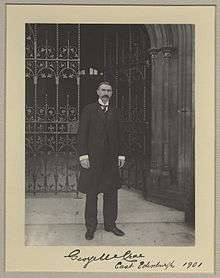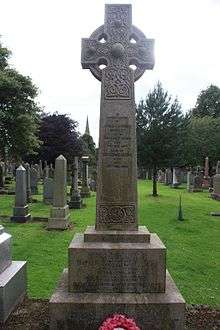George McCrae (politician)


Colonel Sir George McCrae DSO MP (28 August 1860 – 27 December 1928) was a Scottish textile merchant and Liberal Party politician. In Scotland he is best remembered for the creation of McCrae's Battalion also known as the Second Edinburgh Pals Battalion and (officially) the 16th Battalion Royal Scots.
Early Life
Born poor circumstances, in Aberdeen, the illegitimate son of a housemaid, George McCrae was educated at the Lancasterian School, Edinburgh, having been raised by his maternal uncle. He never knew the identity of his father.
Career
McCrae made his mark in the textile trade. He was described variously as a draper [1] or a merchant hosier and mercer [2] In 1909, after a successful career as MP for Edinburgh East, he resigned from the House of Commons to take up a position in Scottish government service, accepting the appointment of Vice-President of the Scottish Local Government Board.[3] From 1919-1922 he served as Chairman of the Scottish Board of Health.[2] He was knighted in 1908.[4]
First World War service
McCrae was a volunteer soldier. In November 1914,[5] before the introduction of conscription, he raised the 16th Battalion the Royal Scots.[6] Among the first recruits were 13 members of the Heart of Midlothian playing squad. At the time Hearts were top of the Scottish League.[5] The battalion was raised in Edinburgh and McCrae commanded it on the Western Front. After what was seen as the battalion’s failure in action in August 1916 however, the divisional commander removed McCrae from command and assigned him to a reserve unit. He was judged to be popular with his men and personally brave but he was thought to have deficiencies as a leader, probably an unwillingness to incur casualties.[7] Despite this judgment of their chief, McCrae's Own, as the battalion was known, had managed to penetrate deeper into the enemy line than any other regiment during the ‘big push’ of July 1916.[8] A memorial cairn dedicated to McCrae’s Battalion was erected in the French village of Contalmaison, a commune in the Somme département where so many of its soldiers fell in 1916.[9][10]
McCrae ended the war with the rank of Colonel and was awarded the DSO.[11]
Politics
Local politics
McCrae became a member of Edinburgh Town Council in 1889. He was a City Treasurer and Chairman of the Finance Committee from 1891–1899 and also served as a Justice of the Peace in Edinburgh [12]
Edinburgh East by-election 1899
In 1899, Robert Wallace, the sitting Liberal MP for Edinburgh East, died causing a Parliamentary by-election. McCrae was selected as Liberal candidate and held the seat over his Liberal Unionist challenger with a majority of 1,980 votes.[13]
| Party | Candidate | Votes | % | ± | |
|---|---|---|---|---|---|
| Liberal | George McCrae | 4,891 | 62.3 | ||
| Liberal Unionist | Harry G. Younger | 2,961 | 37.7 | ||
| Majority | 1,930 | 24.6 | |||
| Turnout | 73.2 | ||||
| Liberal hold | Swing | ||||
1900-1906
McCrae fought Edinburgh East again in 1900, holding the seat with a majority of 1,291 and he successfully defended the constituency again at the 1906 general election this time increasing his majority to 4,174 [14]
| Party | Candidate | Votes | % | ± | |
|---|---|---|---|---|---|
| Liberal | George McCrae | 4,461 | 58.5 | -3.8 | |
| Liberal Unionist | R. Scott-Brown | 3,170 | 41.5 | +3.8 | |
| Majority | 1,291 | 17.0 | |||
| Turnout | 69.2 | -4.0 | |||
| Liberal hold | Swing | -3.8 | |||
| Party | Candidate | Votes | % | ± | |
|---|---|---|---|---|---|
| Liberal | George McCrae | 6,606 | 73.1 | ||
| Liberal Unionist | Rankin Dawson | 2,432 | 26.9 | ||
| Majority | 4,174 | 46.2 | |||
| Turnout | 78.1 | ||||
| Liberal hold | Swing | ||||
In 1909 he resigned from the House of Commons to take up a position in Scottish government service, accepting the appointment of Vice-President of the Scottish Local Government Board.[17]
1917-1922
McCrae sought a return to politics as a supporter of the Coalition Government of Lloyd George. In 1917, the Chief Liberal Whip of the Coalition government, Neil Primrose was standing down from parliament from his seat in England. If a seat could be found for McCrae in Scotland, then it was likely the position of Chief Whip would be offered to him.[18] A vacancy occurred in Edinburgh South but on 19 April 1917, the executive committee of South Edinburgh Liberals, who remained loyal to Herbert Asquith, selected Sir Edward Parrott, the chairman of their Association and of the Edinburgh United Liberal Committee,[19] as their candidate.[20]
Although McCrae remained a supporter of Lloyd George, he was unable to secure a seat for the 1918 General Election in which he could be an endorsed candidate of the Coalition Government. Later, he fought the 1922 general election as a Lloyd George National Liberal at Edinburgh Central. In a straight fight with Labour he trailed sitting MP, William Graham by 3,505 votes.[21]
| Party | Candidate | Votes | % | ± | |
|---|---|---|---|---|---|
| Labour | William Graham | 12,876 | 57.9 | +6.6 | |
| National Liberal | Sir George McCrae | 9,371 | 42.1 | -6.6 | |
| Majority | 3,505 | 15.8 | +13.2 | ||
| Turnout | 71.8 | +26.6 | |||
| Labour hold | Swing | +6.6 | |||
1923-1924
Following Liberal re-union between the supporters of Asquith and Lloyd George, for the 1923 general election McCrae switched his attention to the Stirling and Falkirk Burghs. Standing as a Liberal, McCrae defeated the sitting Labour MP, Hugh Murnin by the narrow margin of 156 votes (which was less than 1% of the total poll).[22] In 1924 he was unable to hold to his gain and Murnin won back the seat with a majority of 1,924 votes.[23]
| Party | Candidate | Votes | % | ± | |
|---|---|---|---|---|---|
| Liberal | Sir George McCrae | 10,721 | 50.4 | +3.7 | |
| Labour | Hugh Murnin | 10,565 | 49.6 | -3.7 | |
| Turnout | 71.7 | 0.0 | |||
| Majority | 156 | 0.8 | 7.4 | ||
| Liberal gain from Labour | Swing | +3.7 | |||
| Party | Candidate | Votes | % | ± | |
|---|---|---|---|---|---|
| Labour | Hugh Murnin | 13,436 | 53.9 | +4.3 | |
| Liberal | Sir George McCrae | 11,512 | 46.1 | -4.3 | |
| Turnout | 81.6 | ||||
| Majority | 1,924 | 7.8 | 8.6 | ||
| Labour gain from Liberal | Swing | +4.3 | |||
Death
In later life he lived at 61 Grange Loan, in the southern Edinburgh suburbs.[26] The house was demolished to build flats in the 1990s.
McCrae died on 27 December 1928 aged 68 years.[27] He is buried in Grange Cemetery in southern Edinburgh. The grave lies on the eastern path close to the main entrance.
Family
In 1890 he married Eliza Cameron Russell (d.1913).[12]
His eldest son, Captain George McCrae, joined the Royal Scots but not in his father's battalion. He died at Gallipoli on 28 June 1915.
His daughter Fiona McCrae MBE (1905-1948) was a Senior Commander.
His son Major William Russell McCrae won the Military Cross.
References
- ↑ The Times, 24 June 1899 p12
- 1 2 Cameron Hazlehurst & Christine Woodland (eds.),A Liberal Chronicle: Journals and Papers of J A Pease, 1908-1910; The Historians Press, 1994 p242
- ↑ Edmund Burke, The Annual Register of World Events: A Review of the Year; Longmans, Green, 1910
- ↑ The Times, 22 July 1908 p15
- 1 2 "Online Exhibitions". national-army-museum.ac.uk.
- ↑ Michael S. Neiberg, The World War I Reader; NYU Press, 2006 p145
- ↑ G. D. Sheffield, Leadership in the trenches: officer-man relations, morale and discipline in the British Army in the era of the First World War; Palgrave Macmillan, 2000 p95
- ↑ http://www.nationalarchives.gov.uk/documentsonline/medals-pals.asp
- ↑ http://www.heartsgreatwarmemorial.org.uk/contalmaison.html
- ↑ "World War One Battlefields : The Somme : Contalmaison". ww1battlefields.co.uk.
- ↑ International Union against Tuberculosis, Transactions of second international conference: London, 26th-28 July 1921; Adlard & Newman, 1921 p xxii
- 1 2 National Liberal Federation, Liberal Central Association (Great Britain), The Liberal Year Book for 1909; Harvester Press, 1909 p62
- ↑ The Times, 24 June 1899
- ↑ The Times, 5 April 1909 p10
- ↑ Debrett's House of Commons and the Judicial Bench, 1901
- ↑ Whitaker's Almanack, 1907
- ↑ Edmund Burke, The Annual Register of World Events: A Review of the Year; Longmans, Green, 1910
- ↑ The Times, 30 March 1917 p7
- ↑ Who was Who, OUP online 2007
- ↑ The Times, 20 April 1917 p3
- ↑ F W S Craig, British Parliamentary Election Results, 1918-1949; Political Reference Publications, Glasgow, 1949 p580
- ↑ F W S Craig, British Parliamentary Election Results, 1918-1949; Political Reference Publications, Glasgow, 1949 p607
- ↑ F W S Craig, British Parliamentary Election Results, 1918-1949; Political Reference Publications, Glasgow, 1949 p607
- ↑ British Parliamentary Election Results 1918-1949, FWS Craig
- ↑ British Parliamentary Election Results 1918-1949, FWS Craig
- ↑ Edinburgh and Leith Post Office Directory 1911-12
- ↑ http://www.leighrayment.com/commons/Ecommons1.htm
External links
- Hansard 1803–2005: contributions in Parliament by Sir George McCrae
| Parliament of the United Kingdom | ||
|---|---|---|
| Preceded by Robert Wallace |
Member of Parliament for Edinburgh East 1899 – 1909 |
Succeeded by Sir James Puckering Gibson |
| Preceded by Hugh Murnin |
Member of Parliament for Stirling and Falkirk Burghs 1923 – 1924 |
Succeeded by Hugh Murnin |